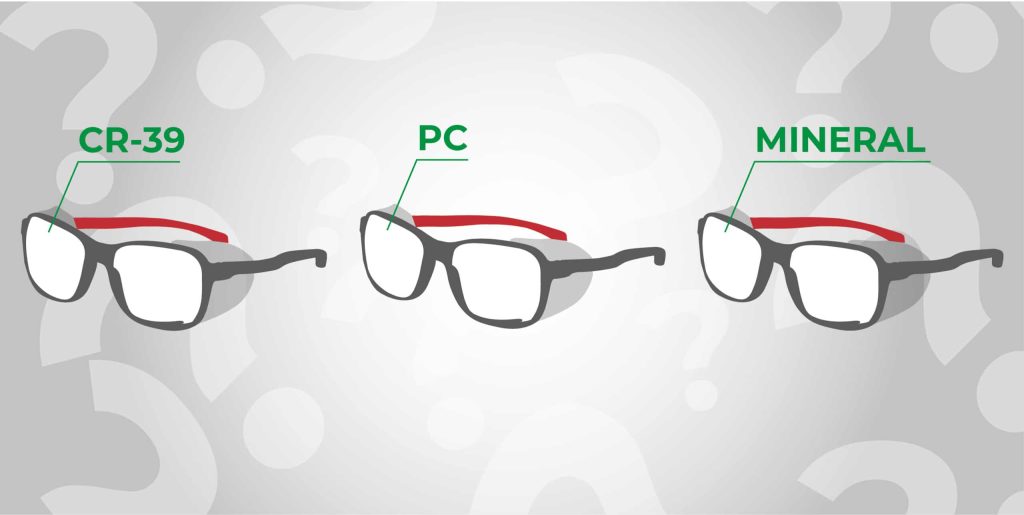In the manufacture of safety glasses, all the components fulfill their function. None of them are assembled without first passing various stress tests.
A shock and impact resistant frame is essential in this type of glasses. But resistant crystals are one of the most important protection elements to keep your eyes safe.
Do you want to know what types of material are used to make the lenses of safety glasses? We'll tell you then.
Work protection glasses with resistant glasses
Protective lenses can be made with three types of materials:
- Organic or CR-39, ideal for adding prescription
- Polycarbonate or PC, very good for neutral and prescription lens
- Mineral, excellent in neutral and graduated
Each material has characteristics that make it unique. All three are worn in work safety glasses.
Organic Lens
The first company to bring low-weight plastic lenses to market was the Armorlite Lens Company of California. It was in 1947.
They were the pioneers in making organic crystals. They made them with a plastic polymer called CR-39. This material is twice as impact resistant as mineral lenses. In addition, it is more durable and resists chemical splashes (anti-liquid).
CR-39 lenses can be put on all kinds of frames. They adapt without problem to any model of safety glasses. They are commonly used for prescription lenses since their optics are good and resistant.
Its main feature is that it weighs very little. This makes protective glasses with organic lenses light and comfortable. A curiosity: organic lenses can be tinted in any color. Unlike polycarbonate or mineral, they only admit certain shades.
Advantage:
- They are lighter, they weigh little
- They can be adapted to any type of frame
Disadvantages:
- Scratch more easily
Polycarbonate or PC lenses
Since 1970, NASA has manufactured the windows of their spaceships with polycarbonate. The helmets of astronauts also carry the visors of this material. The reason is its high resistance to impacts and high temperatures.
Polycarbonate withstands 10 times more shock than organic or mineral material.
The first idea that comes to mind when we talk about resistance is that it must be a very hard material. But actually polycarbonate is flexible. It can withstand impacts from solid materials without breaking thanks to its incredible bending capacity.
Safety glasses with polycarbonate lenses
Protective glasses with polycarbonate lenses are lightweight, feature high impact resistance and provide 100% UV protection.
Polycarbonate lenses scratch more easily than those made of organic or mineral material. But do not worry, good safety glasses always have a hardened treatment that solves this issue.
An example of protective glasses with polycarbonate lenses are the BLACK& WHITE103.03 from Pegaso.They are designed to be used at the same time with hearing protection helmets and their lenses include an anti-fog treatment.
Fact: Have you heard of bulletproof glass? They put them in the security windows of the banks. They are made of polycarbonate for its unbeatable resistance.
Anti-reflective polycarbonate lenses
Can they be bought with anti-reflective treatment? Yes, PC crystals can be prepared to remove reflections from the surface. This treatment improves the visual fatigue produced by flashes of light, while working or driving.
Advantage:
- Very high impact resistance
- Lightweight
- Maximum UV protection
Disadvantages:
- Difficult to stain them
- Slightly less optical quality than other lenses
- If they don't have special treatment, they get scratched
Mineral lenses
Mineral lenses are those that have been used throughout life. They are made with a mixture of silica and metal oxides such as titanium or sodium.
The result is a hard glass that is very difficult to scratch. This is the quality that characterizes it. This hardness is also its weakness. Lacking flexibility against possible impacts, it breaks and splinters easily.
In any case, a mineral treatment can also be applied to harden them and thus extend their useful life.
In any case, a mineral treatment can also be applied to harden them and thus extend their useful life.
Many people prefer mineral glass in their glasses for its aesthetic appearance and remarkable optical quality.
A tip: If you work with chemicals, this material will effectively protect your eyes in case of splashes.
Advantage:
- Scratch resistance
- Unbeatable optical quality
- High resistance to chemicals
Disadvantages:
- They weigh much more than other materials
- They break more easily
Can all types of safety glasses lenses graduate?
Any of the three materials that we have told you about can graduate. Depending on your type of work and the level of protection you need, you must choose the right type of glass to be more protected.
From Pegaso we recommend advising you on your trusted optic before deciding on one or another type of lens.
